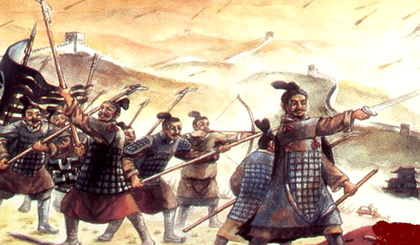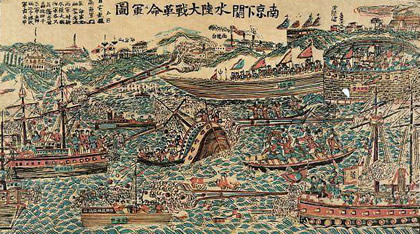World History
In 751 a Tang (T’ang) dynasty army commanded by Gao Xianzhi (Kao Hsien-chih), military governor of Anxi (An-hsi) in the Western Regions, met an Arab army in battle at Talas River near Samarkand. The Chinese were defeated. Although this was not a major military confrontation, it had great consequences.
Tang power and prestige stood at their zenith up to 750. Tang military forces had scored major successes and secured the frontiers from Tibet to Central Asia; the northern steppes were under a friendly semisedentary people called Uighurs, while the Khitans in the northeast and the Xixia (Hsi Hsia) in the southwest were contained.
International trade flourished by land along the Silk Road, and by sea routes. However soon all would change. The aging Emperor Xuanzong (Hsuan-tsung), infatuated with a young concubine, the Lady Yang (Yang Guifei), had been neglecting his duties while her corrupt family and favorites dominated the government.
The military system that had made the empire strong during the previous 100 years was deteriorating. Many of the frontier garrisons were manned by nomadic mercenaries and commanded by non-Chinese generals. Meanwhile Muslim Arab power had been expanding eastward.
The conflict began as one between two local states, Ferghana, a Chinese client state, and Tashkent. It led to battle between Ziyad bin Salih, governor of Samarkand under the Ummayyad Caliphate, assisting Tashkent, and General Gao Xianzhi and his Chinese forces. Gao was badly defeated when his ally the Western Turks defected to the Arabs and retreated across the Pamir Mountains.
The battle was not significant in the short term, because the Arabs did not press eastward to threaten China, but because of what followed in the long term. In the same year, nearer to home, the aborigines in Yunnan in southwestern China revolted and declared independence, creating a state called Nanzhao (Nan-chao).
Finally in 755 the Turkic general and once imperial favorite An Lushan (An Lu-Shan) began a rebellion that captured both Tang capital cities and threatened the throne.
The immediate result of events in 755 was the recall of Chinese forces from Central Asia, creating a political vacuum. That left the Arabs in a strong position. Likewise the power vacuum enabled the Tibetans and the Xixia people to expand their power at China’s expense.
Even as an ally the Uighurs expanded their power at the Tang’s expense. Without Chinese military protection the Buddhist states in Central Asia would fall to the rising power of Islam. Chinese power would not return to the region for another 600 years.
- Five Dynasties Of China
Five Dynasties of China The great Tang (T’ang) dynasty, founded in 618, was wrecked by the Huang Zhao (Huang Ch’ao) Rebellion that lasted between 875 and 884. It was put down only with the help of regional warlords and Turkic allies (the...
- Tang (t’ang) Dynasty
Tang (T’ang) Dynasty The Tang dynasty (618–907) brought three centuries of greatness to China, called the second imperial age, continuing and consolidating the unification of China that the preceding Sui dynasty (581–618) had begun....
- Tenchi (tenji)
Tenchi (Tenji)The man who later became Emperor Tenchi played a major role in the coup d’etat that ousted the Soga clan from power in Japan in 645. His reign was remarkable for the many steps taken to advance Japan by implementing reforms modeled...
- Tibetan Kingdom
Tibetan Kingdom The Tibetan kingdom was at its height during the seventh and eighth centuries. After 842 a schism in the ruling lineage led to decline, decentralization, and civil wars. The Tibetan kingdom submitted to Genghis Khan in the early 13th century...
- Uighur Empire
From the fifth century Turkic tribal groups under various names were found living beyond China’s northern borders from Korea to Central Asia. With China divided the Turks first preyed on, then conquered and ruled parts of northern China in many...
World History
Battle of Talas River
 |
| Battle of Talas River |
In 751 a Tang (T’ang) dynasty army commanded by Gao Xianzhi (Kao Hsien-chih), military governor of Anxi (An-hsi) in the Western Regions, met an Arab army in battle at Talas River near Samarkand. The Chinese were defeated. Although this was not a major military confrontation, it had great consequences.
Tang power and prestige stood at their zenith up to 750. Tang military forces had scored major successes and secured the frontiers from Tibet to Central Asia; the northern steppes were under a friendly semisedentary people called Uighurs, while the Khitans in the northeast and the Xixia (Hsi Hsia) in the southwest were contained.
International trade flourished by land along the Silk Road, and by sea routes. However soon all would change. The aging Emperor Xuanzong (Hsuan-tsung), infatuated with a young concubine, the Lady Yang (Yang Guifei), had been neglecting his duties while her corrupt family and favorites dominated the government.
  |   |
The military system that had made the empire strong during the previous 100 years was deteriorating. Many of the frontier garrisons were manned by nomadic mercenaries and commanded by non-Chinese generals. Meanwhile Muslim Arab power had been expanding eastward.
The conflict began as one between two local states, Ferghana, a Chinese client state, and Tashkent. It led to battle between Ziyad bin Salih, governor of Samarkand under the Ummayyad Caliphate, assisting Tashkent, and General Gao Xianzhi and his Chinese forces. Gao was badly defeated when his ally the Western Turks defected to the Arabs and retreated across the Pamir Mountains.
The battle was not significant in the short term, because the Arabs did not press eastward to threaten China, but because of what followed in the long term. In the same year, nearer to home, the aborigines in Yunnan in southwestern China revolted and declared independence, creating a state called Nanzhao (Nan-chao).
 |
| Battle at Talas River |
Finally in 755 the Turkic general and once imperial favorite An Lushan (An Lu-Shan) began a rebellion that captured both Tang capital cities and threatened the throne.
The immediate result of events in 755 was the recall of Chinese forces from Central Asia, creating a political vacuum. That left the Arabs in a strong position. Likewise the power vacuum enabled the Tibetans and the Xixia people to expand their power at China’s expense.
Even as an ally the Uighurs expanded their power at the Tang’s expense. Without Chinese military protection the Buddhist states in Central Asia would fall to the rising power of Islam. Chinese power would not return to the region for another 600 years.
- Five Dynasties Of China
Five Dynasties of China The great Tang (T’ang) dynasty, founded in 618, was wrecked by the Huang Zhao (Huang Ch’ao) Rebellion that lasted between 875 and 884. It was put down only with the help of regional warlords and Turkic allies (the...
- Tang (t’ang) Dynasty
Tang (T’ang) Dynasty The Tang dynasty (618–907) brought three centuries of greatness to China, called the second imperial age, continuing and consolidating the unification of China that the preceding Sui dynasty (581–618) had begun....
- Tenchi (tenji)
Tenchi (Tenji)The man who later became Emperor Tenchi played a major role in the coup d’etat that ousted the Soga clan from power in Japan in 645. His reign was remarkable for the many steps taken to advance Japan by implementing reforms modeled...
- Tibetan Kingdom
Tibetan Kingdom The Tibetan kingdom was at its height during the seventh and eighth centuries. After 842 a schism in the ruling lineage led to decline, decentralization, and civil wars. The Tibetan kingdom submitted to Genghis Khan in the early 13th century...
- Uighur Empire
From the fifth century Turkic tribal groups under various names were found living beyond China’s northern borders from Korea to Central Asia. With China divided the Turks first preyed on, then conquered and ruled parts of northern China in many...
